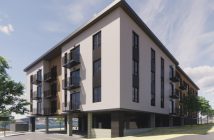After the cataclysmic fluctuations following the “Great Recession” of the late 2000s, the general consensus is that the Bend real estate market has witnessed an uptick in activity recently, with indications of both stabilization and positive future trends.
On the commercial front, following a period of relative stagnancy, several exponents report increased volume on several fronts within the last year.
The general environment has been helped, in part, by the working through of distressed – once labeled “toxic” – asset inventory and a relative, though still tentative, return towards more confidence regarding general economic conditions, somewhat buoyed by continuing historically low interest rates and a consolidation of property values typically linked to income generation potential.
Brian Fratzke, Principal of Fratzke Commercial Real Estate, observed, “We have seen an increase in the number of commercial building sales over the past 12 months. Most of the sales were in the office and industrial sector by owner/users that determined that the monthly debt service in a purchase scenario was less that the monthly rental payment in a lease scenario.
“I believe we will continue to see demand on behalf of the owner/user sector in 2012. Unfortunately, we are experiencing a limitation in the available inventory as most lenders have worked through their distressed assets and many landlords that were underwater have faced the music and dealt with their non-performing asset.
“Beginning in October 2011, we began to see our first commercial land sales take place in Bend in three years and I believe commercially zoned land will continue to be sold especially in the retail and office sectors.
“There is little to no inventory in the industrial sector for suites ranging between 1,000 to 1,800 square feet and for the first time since 2008 lease rates are beginning to increase slowly for small industrial space.
“We have very little retail space for lease and for the first time since 2007 our firm is leasing more space to new businesses instead of just moving tenants around from space to space. High quality office space especially in the medical sector is in great demand and we leased over 100,000 square feet in the first quarter of 2012.”
Fratzke said his firm continues to increase the number of lease and sale transactions and recently closed a 5+ acre parcel of land sold to Goodwill Industries in Redmond, which plans a new building as well as development of retail/food use pad sites.
He concluded, “Overall, it’s good news in the commercial sector but given how the market beat us up over the past 4-5 years, we are extremely cautious that we are out of the woods. There is effectively no new speculative commercial development taking place in the private sector.
“Neither the lending community nor the current lease rates will support such new development at this time and we are watching the market and advising our developer clients as to the best time to re-enter an extremely sensitive and complicated market.”
Darren Powderly, president of Compass Commercial Real Estate Services, concurred that there had been a relatively recent surge in business, adding, “At Compass Commercial we have experienced an increase in business activity over the past 180 days.
The increased activity levels can be felt across all property sectors including office, retail and industrial spaces.
“If current leasing activity levels sustain through 2012, we anticipate an increase in rental rates for 2013 and beyond. Once rental rates increase, then property value appreciation will follow.
“Another very positive trend is the decreased inventory of bank-owned commercial real estate listings due to an increase in sales activity and a decrease in foreclosures. At Compass, we believe that Central Oregon is well positioned for a healthy and sustained economic recovery.”
Peter Lowes, principal of the Lowes Group, also observed, “In the last six months we have seen an overall increase in activity. We are seeing multiple offers occurring on select properties, 1031 (tax deferred) exchange buyers re-surfacing and strong talk once again of a four year university in Bend.
“Also buyers are taking advantage of historically low fixed interest rates. Because of the decline in bank-owned inventory, and new building starts on the rise, both in residential and commercial sectors, we at the Lowes Group expect the market to continue to appreciate in all sectors for the next several years, this includes increasing rental rates in commercial and residential sectors, which in turn leads to value gains.”
Scott Gibbs, certified property and asset manager of Lowes Property Managemen, also alluded to an atmosphere of consolidation. He said, “After four years of declining property values, commercial real estate valuations have stabilized which has contributed to an accelerated absorption of distressed assets over the last eighteen months.
“Commercial real estate represents an attractive opportunity for qualified buyers with cash and credit, with lower valuations and low interest rates for qualified buyers coupled with the lack of competing investment options.
“The same is true in the residential market: just look what is happening in Phoenix with Canadian buyers with cash and no place to put it.”
The real-world observations are also bolstered by the latest National Association of Realtors quarterly commercial real estate forecast, which indicates that nationally all major commercial real estate sectors are seeing improved fundamentals.
Lawrence Yun, NAR chief economist, said vacancy rates are improving in all of the major commercial real estate sectors. “Sustained job creation is benefiting commercial real estate sectors by increasing demand for space,” he said. “Vacancy rates are steadily falling. Leasing is on the rise and rents are showing signs of strengthening, especially in the apartment market where rents are rising the fastest.”
RENTAL MARKET
The rental market has undergone some dramatic changes since the real estate bubble burst several years ago. Recession conditions and continued lagging in the economic recovery have led to more renters and subsequently rising rental rates
Over the next year vacancy rates are expected to decline even further. The office sector is forecasted to see a 0.4 percent decline. The industrial real estate market is forecasted for an 0.8 percent decline and 0.9 percent in the retail sector. The multi-family rental market is expected to see a 0.2 percent decline this year.
This projection will continue to increase the role of the landlord seeking bigger rent increases.
After rising 2.2 percent last year, average apartment rent is expected to increase 3.8 percent in 2012 and another 4 percent next year. Multifamily net absorption is forecast at 209,900 units this year and 223,600 in 2013.
Vacancy rates for the multi-family market, specifically, are likely to drop from 4.7 percent this first quarter to 4.5 percent in the first quarter of 2013.
RESIDENTIAL HORIZON
And there are similar positive rumblings on the residential horizon, in a sector which is typically lagged by commercial indicators.
Pat Huber, owner of RE/MAX Key properties in Bend said, “At RE/MAX we track the Bend market in four segments: traditional resale, short sales, bank-owned and new construction. This is a good way to understand where we are in recovery.
“Some things to note through the end of the first quarter of 2012 are that Bend closed units are up by 4 percent compared to Q1 last year and also show an increase of 4 percent in average sales price. Days on market are down by 5 percent, so overall our market is healthier than last year.
“When we look at our main segments we see that 32 percent more traditional resale units closed this quarter compared to last quarter with a price increase of over 2 percent.
“When it comes to short sales, the amount closed in the first quarter of 2012 is 32 percent less than last year – although prices did decrease year to year by about 8 percent. However, bank-owned units closed in Q1 are also down 18 percent, but with a surprising increase in price of over 9 percent.
“What these first three segments indicate is that bank-owned and short sales are making up less of our market with bank pricing actually increasing from last year. Additionally, the standing inventory of distressed properties in Bend is now 30 percent of our market versus over 40 per cent last year at this time.
“This indicates that the Bend market is on the mend. Our RE/MAX office has seen considerably more multiple offer situations in the past few months – across all segments of the Bend market.
“This is an indication that buyers believe that the ‘best deals’ are being snapped up and there has been a tipping of the supply/demand equation from the buyer’s side to the seller’s side in certain situations.”
Huber said probably the leading indicator of a healthy market is the level of new construction units that are closing. This segment in Bend is up by 45 percent in volume compared to last quarter.
She added, “More significant is the average selling price for new construction. While normally one would not be happy to hear that this has decreased year to year – that is exactly what we needed to see.
“For the past four years, the majority of new construction was high end, custom homes or specifically on the West side of town. For Q1 2011 only 15 percent of new construction homes closed were under $250,000.
“This latest quarter over 45 percent of new construction units were homes sold under $250,000. Buyers are realizing that they can afford a newly constructed home in Bend at close to the same price as a short sale or bank-owned property.
“This is the signal that we have turned the corner and are moving forward again.”
Recent figures show residential sales still extremely active in the lower end of the market up to $300,000, with brokers observing that it is not unusual for buyers in that price range to find themselves in a multiple offer scenario.
Buyers were also circling in the higher end of the market, if the home is priced competitively, and some 94 percent of the single family homes (on less than one acre lots) that sold during the past six months were below $500,000.
Based on sales in Bend for the past six months, there appears to be less than a four-month supply for residential homes up to $300,000, with a number of qualified buyers looking to purchase.




